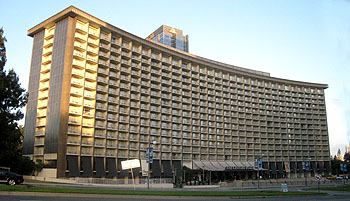 The new owners of the Century Plaza Hotel in Los Angeles want to tear it down and replace it with a pair of 50-story towers containing condos, offices, shops and a smaller luxury hotel. But not everyone is thrilled:
The new owners of the Century Plaza Hotel in Los Angeles want to tear it down and replace it with a pair of 50-story towers containing condos, offices, shops and a smaller luxury hotel. But not everyone is thrilled:
The Los Angeles Conservancy is determined to stop them. To bolster its campaign, it has enlisted the National Trust for Historic Preservation, which today put the 726-room Hyatt Regency Century Plaza hotel on its annual list of America’s 11 most endangered historic places.
“By naming this structure to the list, the National Trust is demonstrating that the preservation of recent past and modern buildings is as important to our cultural record as preserving architecture that’s from the Victorian period or Art Deco era,” said Christine Madrid French, director of the trust’s nascent Modernism + Recent Past Initiative.
This is lunacy. I don’t care one way or another whether Michael Rosenfeld gets to build his new complex, but it makes a mockery of historic preservation to pretend that this building deserves to be protected for the rest of time. It was built in 1966. Its architect, Minoru Yamasaki, is prominent, but he’s not a native Angeleno and this wasn’t a pivotal work in his career. The building itself is a fine example of 60s-era modernism, but that’s just another way of saying that it’s also a fairly typical example of 60s-era corporate hotel design. In its heyday, which lasted for perhaps two decades at most, the Century Plaza attracted plenty of VIP guests, but it never became an iconic structure because of that. The Los Angeles Conservancy’s page about the hotel is here, and they pretty obviously struggled to figure out a way to make it seem even moderately noteworthy.
The Century Plaza Hotel is a recent building of genuine but modest distinction. But it escapes me how that qualifies it as a national historic place. Pretending otherwise does a disservice to genuine history.
















